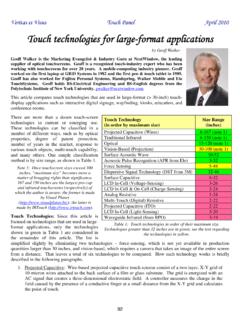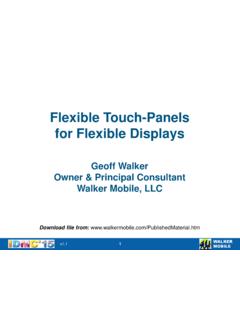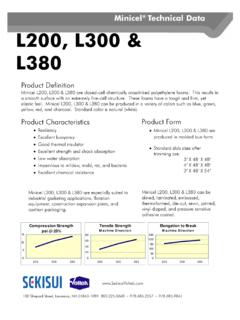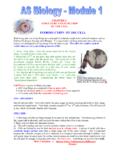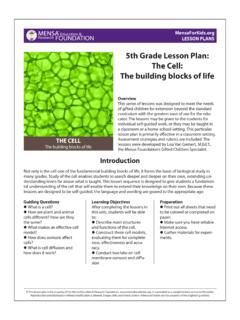Transcription of LCD In-Cell Touch - Walker Mobile
1 THE term In-Cell Touch generally refersto the implementation of a Touch sensor insidethe cell of a liquid-crystal display (LCD).While the term and technology have beenapplied to Touch sensors integrated intoplasma-display panels, electrophoretic (electronic paper) displays, and OLEDs, thisarticle examines only the application in LCDs. LCD In-Cell Touch currently exists in threeforms, only one of which is physically insidethe LCD cell. The three forms are as follows: In-Cell :The Touch sensor is physicallyinside the LCD cell. The Touch sensorcan take the form of light-sensing ele-ments, micro-switches, or capacitiveelectrodes. On-cell:The Touch sensor is an X-Yarray of capacitive electrodes depositedon the top or bottom surface of the color-filter substrate.
2 Strictly speaking, whenthe electrodes are on the bottom surfaceof the substrate they are physically insideLCD In-Cell Touch Imagine being able to Touch the surface of any display with your finger or a stylus and have the location of your Touch instantly identified down to the exact pixels. Imagine this happening with no cover glass or special coatings or any other obstruction in front of the display, and with minimal change inside the display. That s the promise of In-Cell Touch . The problem is that the promise remains mostly out of reach. This article explores thatpromise and its current status in Geoff Walker and Mark FihnGeoff Walkeris the Marketing Evangelist &Industry Guru at NextWindow, the leading supplier of optical Touch screens.
3 He is theGuest Editor for this issue of Information Display, is a recognized Touch -industry expertwho has been working with Touch screens for20 years. He can be reached at 408/506-7556and Mark Fihnis publisher of the Veritas et Visus newslet-ters, focused on the technologies and marketsrelated to flexible displays, display-relatedstandards and regulations, 3-D displays,high-performance displays, and touchscreens. He can be reached at 254/791-0603or Display 3/100362-0972/03/2010-008$ + .00 SID 2010frontline technologyTable 1: The difficulty of integrating each of 11 Touch technologies as out-cell Touch is shown as green (easy), yellow (medium), and red (hard) Touch TechnologyDifficulty of Out-Cell IntegrationAnalog & Digital ResistiveNoneProjected CapacitiveNoneOpticalCameras & reflectors can be mounted on top of the LCDcell; no cover glass is requiredTraditional InfraredA PCB must surround the entire LCD.
4 No cover glass isrequiredSurface CapacitiveThe metal LCD frame cannot contact thetouch-screen glass and must be groundedSurface Acoustic WaveThe reflectors and transducers on the Touch -screen glassmust be protectedWaveguide Infrared (RPO)Waveguides and sensors must be mounted on the surfaceof the Touch -screen glass; IR LEDs must be attached tothe edge of the glassAcoustic Pulse Recognition Touch -screen mounting is critical(Elo TouchSystems)Dispersive Signal Technology (3M) Touch -screen mounting is criticalForce SensingTouch-screen mounting is criticalVision-Based OpticalNot applicable (rear-projection only)the cell but this is still usually called on-cell because of the type of elec-trodes.
5 (This is a good illustration of thefact that the terminology for In-Cell touchis still evolving.) Out-cell:This new term, coined in 2009by AU Optronics Corp., describes theconfiguration in which a standard touchscreen (usually only resistive or pro-jected capacitive) is laminated directlyon top of the LCD during module manu-facturing. Unlike the other two, this con-figuration typically requires an additionalpiece of glass even though it is techni-cally possible to use a film film resistivetouch screen in this these terms and the technologythat they describe are quite new, there is stillquite a bit of variation in their use in technicaland marketing documents. Caution is advisedwhile reading any relevant material; on-cell may often be used to describe something thatis actually out-cell, and TouchOut-cell is basically just the integration of atouch solution at the LCD-module manufac-turer.
6 This is not fundamentally different thanthe Touch integration that is often performedby third-party integrators today. The majordifference is that it is likely to be lower cost,which means that out-cell is probably going tobecome a general trend, one most likely tooccur with technologies that are easy to inte-grate. Table 1 categorizes all current touchtechnologies in terms of the difficulty of integrating them as out-cell shown in Table 1, resistive and pro-jected-capacitive Touch screens are the mostlikely candidates for out-cell two most commonly used technologiesaccounted for over 95% of the total number oftouch screens shipped in 2009. Both are oftenattached to LCDs by third-party integrators,so it is easy for the LCD-module manufac-turer to do the same.
7 Projected-capacitivesensors are increasingly being made on con-verted color-filter fab lines, so LCD manufac-turers have easy access to the technology. Allof these factors are causing a number of well-known resistive and projected-capacitivetouch-screen manufacturers to begin to workclosely with major LCD manufacturers onout-cell integration. Among the other touchtechnologies, only optical seems to be gainingany acceptance from the LCD manufacturersin terms of out-cell and On-Cell Touch TechnologiesThere are currently three different Touch tech-nologies being used in In-Cell and on-celltouch. They are summarized as follows: Light Sensing ( In-Cell ):This technol-ogy, also called optical, uses the addi-tion of a photo-transistor into some or allof the LCD s pixels.
8 The screen can betouched with a finger, stylus, light-pen,or laser pointer. The Touch -sensing arraycan also be used as a scanner. A cover-glass can be used to protect the LCD ssurface. Voltage Sensing ( In-Cell ):This tech-nology, also called switch sensing, uses the addition of micro-switches for X and Y coordinates into each pixel orgroup of pixels. The screen can betouched with a finger or a stylus, withinthe damage limits of the LCD s cover-glass cannot be used to protectthe LCD s surface. Charge Sensing ( In-Cell ):This technol-ogy, also called pressed capacitive, uses variable-capacitor electrodes in eachpixel or group of pixels. The screen canbe touched with a finger or stylus, withinthe damage limits of the LCD s cover-glass cannot be used to protectthe LCD s surface.
9 Charge Sensing (On-Cell):This tech-nology, also called capacitive sensing, is basically the same as today s projectedcapacitive. It uses an X-Y array ofcapacitive-sensing electrodes on the topsurface of the color-filter substrate. Thescreen can be touched only with a cover-glass can be used to protect theLCD s 2 shows which LCD manufacturersare working on each of the three In-Cell /on-cell technologies. This list, based on investi-gation done by the authors, is undoubtedlyboth incomplete and inaccurate because notall manufacturers are forthcoming about theirin-progress research. The authors take fullresponsibility for all errors and theoretical advantages of In-Cell touchhave always seemed very attractive.
10 Theseinclude the following: Minimal or no added size, thickness, orweight (and therefore no effect on theend product s industrial design) in orderto achieve the Touch function. Theoretically unlimited (controller-dependent) multi- Touch functionality,since each pixel or group of pixelsshould be individually detectable. Conceptually very high Touch -perfor-mance, including low parallax error(assuming no cover-glass), very accurateand linear Touch -point data (due to theunchanging underlying pixel matrix), andpotentially higher resolution than theLCD (through inter-pixel interpolationwhen a sensor is present in each pixel). Theoretically much lower cost for thetouch function, since the changes in anLCD s manufacturing cost should reality, all of these advantages haveturned out to be compromised to some next several sections of this article delveinto each of the three technologies and theiradvantages and disadvantages in more Display 3/109 Table 2: In-Cell and on-cell Touch technologies are being investigated by various LCD manufacturers.

